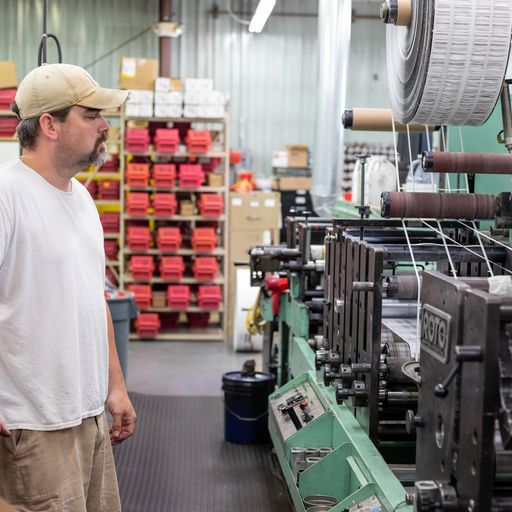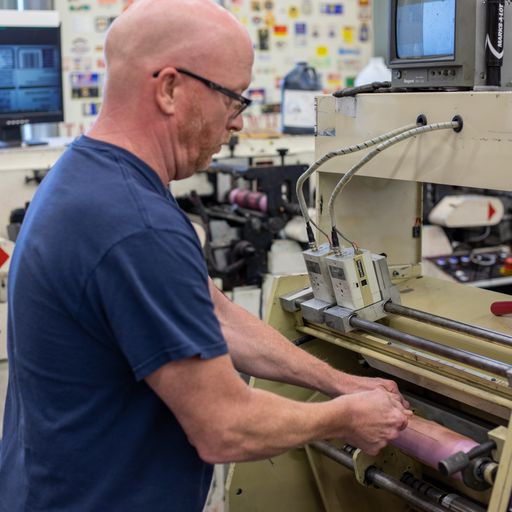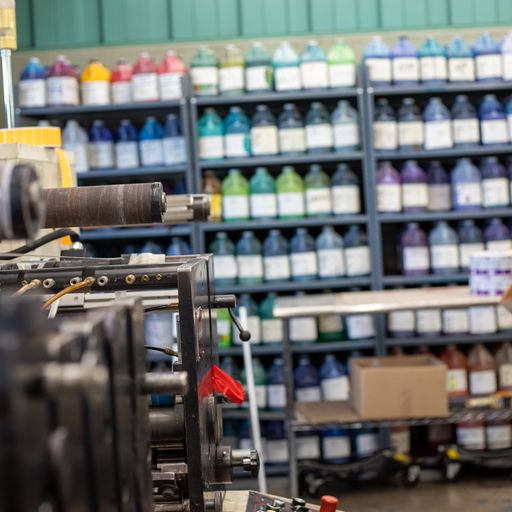Flexo printing is a process of printing in which flexible relief plates get rolled over your labels like a stamp in order to make packaging labels. It’s good to think of flexo printing like a letterpress, but a more high-speed and modern version. This is a great way of printing because it’s cost-effective, fast, and can print on a variety of different substrates.

Looking for flexo printing services? Mammoth Labels & Packaging provides flexo and digital printing services. Contact us at (800) 452-9010 to get a quote on high-quality packaging labels today.
We use flexo printing to create the following types of packaging labels. Don’t see the product you need in this list? Let’s talk! This is just a selection of the many packaging solutions we can make for you. Get in touch with us today to learn more and get a quote.

Flexographic printing allows us to print packaging labels on a wide variety of substrates. Here’s a complete list of all the materials we can print on. Don’t see your label substrate in this list? Contact us today to see what we can do.
Mammoth Labels & Packaging currently delivers custom flexo packaging solutions to the following markets:
Flexo printing is a cost-effective printing method if you need to produce a large number of packaging labels. The ink is inexpensive, and the relief plates are durable and easy to replace.
Need your labels made fast? Flexographic printers run at extremely high speeds, operating at 750m/2,000 ft. per minute. Once your flexographic printing plates have been made, the printing process doesn’t take long at all. We do our best to ship within 8 business days from proof approval.
In the past, flexo printers had problems with halo effects and dot bridging. Thanks to recent developments in flexo printing technology, we can now produce high-quality labels with clear texts, crisp colors, and beautiful designs.
Flexo printing can be used to print labels on a wide variety of substrates. We can print labels on paper, plastic, cardboard, cellophane, foil, non-woven fabric, metal, multilayered film composites, and more. Flexo printing also allows us to use water-based, solvent-based, and UV-curable inks.
Need your labels laminated, varnished, embossed, or die-cut? No problem. With flexo printing, we can integrate these processes in a single pass. This is a huge advantage that flexography has over other printing methods. Others require you to complete these processes separately.
Want to learn more about flexographic printing? Flexographic printers have two rollers and two cylinders that work together to make your labels. Here’s how the process works:
What’s the difference between flexographic printing and digital printing? Which method is best for your labels? Here’s our quick guide:
Flexo printing is like using a stamp. Ink is applied to rubber printing plates that have a raised image of your label design on them. These flexible relief plates are attached to cylinders and rolled over the surface of your label material.
Digital printing is when a digital image is printed on a label material’s surface by directly applying toner to it. It works like the color copier in your home or office.
Some of our clients find that a combination of flexo and digital printing is best. This is especially true if they have multiple product lines.
Flexo printing is ideal for your products that are popular and widely distributed. You can save money by flexo printing these labels in bulk.
Digital printing, on the other hand, is ideal for your new products that aren’t widely distributed yet. It’s more cost-effective to print smaller orders digitally. Plus, it’s easier to make changes to your label design when you print digitally.
At Mammoth Labels & Packaging, we offer both flexo printing and digital printing services. Contact us today to learn more about which type of printing is best for you. We’d be happy to help you put together a plan for all your product lines.
Another printing method we get asked about is offset printing. What’s the difference between flexo printing and offset printing? Flexo printing uses flexible relief plates to print your design directly on the substrate, while offset printing prints your design indirectly through a set of offset plates. Each method has its advantages, but label printers typically prefer flexographic printing for its ability to scale and adapt. Here’s what sets flexo apart:

Flexo printing can be used to print on a wider variety of substrates, both absorbent and non-absorbent. Offset printing can only be used to print on flat, smooth surfaces.
Flexo printing can be combined with digital printing to create hybrid packaging solutions. This makes flexo printing a more flexible printing method.
Flexo printing allows us to carry out secondary processes like lamination, varnishing, embossing, folding, and die-cutting in a single pass. Offset printers can’t handle these extra processes.
Our flexo presses can print on papers (semi-gloss, thermal transfers), plastics (BOPP, films), and wood-based substrates.
Flexo printers can print labels with water-based, soy based, and UV-curable inks.
Our flexo printers can hit all Pantone colors and special custom matches.
Yes, if you do not have a Pantone color to use, then providing us with a sample or swatch will allow us to color match.
Flexographic presses use flexible relief plates to lay the ink down on your packaging material like a stamp. Each color in your design requires a separate plate to be made.
We do not have a minimum label quantity, but our minimum order price is $260 not including the costs of tooling, taxes, and shipping. If you have a smaller order, we recommend using our digital printing services. Digital printing is more cost-effective for smaller orders, while flexo printing is more cost-effective for larger orders.
Our flexo printers run at 600 ft/minute.
We do our best to ship within 8 business days from proof approval. Sometimes material delays affect this. We communicate expected ship dates from the day your order is confirmed to the day your order is shipped.
Looking for a flexo printing supplier? Mammoth Labels & Packaging provides flexographic and digital printing services. Call us at (800) 452-9010 to get an estimate on high-quality packaging labels today.